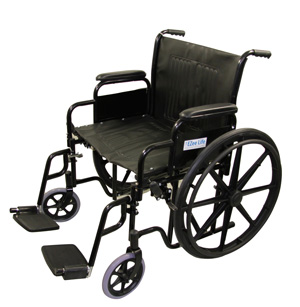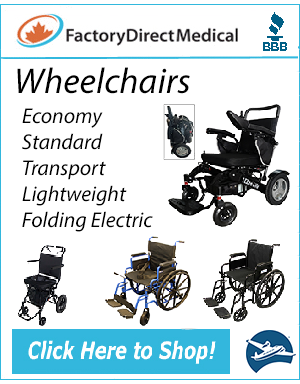Standard Manual Wheelchairs
Standard wheelchairs are the most basic of the categories that self propulsion is an option. Standard wheelchairs are intended for short term use and although seating systems can be added to the wheelchair this category isn't often chosen for those who will be using a wheelchair on a regular basis. The advantages of the standard wheelchair is it is sturdy and inexpensive. The disadvantages are they are heavy, are available in limited sizes, have few options available and no adjustability for comfort or to ease propulsion. The standard wheelchair is the type of wheelchair many department stores and institutions offer as loaner wheelchairs or wheelchair vendors will offer as rental wheelchairs for short term use.
The weight of these wheelchairs make them difficult to use in any terrain other than flat, solid, smooth surfaces. While they can be propelled independently, they are more suited to situations where a caregiver of helper is around to help when needed.
Seat Widths and Depths
Seat widths available for standard wheelchairs will be 16", 18" or 20". The choice between 16" or 18" will not normally incur an upcharge but the models that offer 20" widths will charge an extra fee. The seat depth for almost every model will be 16" which is suitable for almost everyone except the very shortest adults or the very tallest. Rarely a model will offer a 18" seat depth at an added expense. In situations where the standard seat depth of 16" is too deep, the seat upholstery can be removed, shortened and reinstalled (Shorting the seat depth will require cutting and re-sewing but it can be done.
Frames, Weight & Capacities
Most standard wheelchairs will have steel folding frames and vary in weight between 30 lbs. and 50 lbs. When comparing wheelchair models it's important to take notice of what parts are on the chair. Many wheelchair manufacturers will publish weights without footrests and/or arms and/or other parts. The weight capacities are normally 250 lbs. to 300 lbs.
Casters, Wheels and Tires
The most common wheel configuration for standard wheelchairs is two 8" casters on the front and two 24" wheels on the back with solid tires on both. Some models may offer different sizes but there is likely to be a fairly hefty upcharge. Air will give a little bit softer ride and traverse rough terrain a little better but if not fully inflated they will actually make the wheelchair harder to push.
Brakes
All standard wheelchairs will have brakes mounted near the front of the side frame which press on the tires to prevent the wheelchair from rolling. Brakes on a wheelchair are not designed to work like a car or bicycle, they are only used to "park" the wheelchair and not used to slow it down when moving.
Armrests
Standard wheelchairs can have full or desk length arms and they may or may not be removable but you probably won't often get an option. In cases where you will have an arm style choice there will almost certainly be an upcharge for any style other than the standard arm.
Footrests
Standard wheelchairs always have some type of footrest included in the base price of the chair but most also offer elevating legrests as options. Choosing elevating legrests on a standard wheelchair will incur an upcharge which on some models is fairly insignificant but on others quite expensive. If elevating legrests are required, it's a good idea to shop around and check out different models
Pros
- Inexpensive ($200.00 - $500.00)
- Strong (250 to 300 lbs. capacity)
- Low maintenance
- Durable
Cons
- Heavy (for lifting & propelling)
- No adjustability
- Few sizing options
- Few accessories available
- Difficult to make comfortable



 Online Vendors
Online Vendors  US Online Vendors
US Online Vendors 



